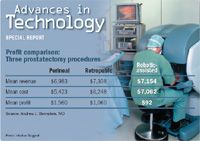Article
Robot-assisted radical prostatectomy is not (yet) cost-effective
Rochester, NY--Use of the daVinci robot (Intuitive Surgical, Sunnyvale, CA) for radical prostatectomy procedures is not currently profitable, but it has the potential to become profitable, according to two studies presented at the AUA annual meeting. However, the studies' authors say that the costs associated with robotic procedures must eventually come down because the technology is here to stay.

"The costs will eventually come down as market forces influence the field," said co-author and surgeon Hitendra R.H. Patel, MD, PhD, from the Institute of Urology, University College Hospital, London. "Owning a robot can be profitable for a hospital by direct, but mainly indirect means. The publicity that it generates attracts people to the hospital to have other treatments."
The study was presented by lead author Jean Joseph, MD, MBA, head of laparoscopy and robotics in the department of urology at the University of Rochester, New York.

Andrew J. Bernstein, MD, a urology resident at William Beaumont Hospital, Royal Oak, MI, also presented a study evaluating the cost benefits of the robot based on procedures performed at William Beaumont. While he and his colleagues found that the laparoscopic robotic-assisted prostatectomy is at a profit disadvantage compared to the retropubic and perineal approaches, they are optimistic that the robotic approach could become profitable in the future.
"As operative times decline, laparoscopic robotic-assisted prostatectomy may approach a profit margin similar to perineal prostatectomy," Dr. Bernstein said.
Net losses for the hospital
To evaluate costs, the team from Rochester reviewed 174 robotic procedures performed at the University of Rochester Medical Center over a period of 18 months. Almost all of the procedures were prostatectomies (94%), while pyeloplasties accounted for 4% and cardiac valve repairs for the remaining 2%. The total hospital cost per radical prostatectomy was $9,102. Specifically, the fixed and variable costs per case totaled $2,949 and $6,153, respectively; and average cost of reposables and disposables per case were $1,138 and $1,577, respectively. The initial cost of the robot approached $1 million, and all other costs, including repair, totaled $330,000 during the study.

The researchers from William Beaumont reviewed hospital operative records and financial data for all 267 patients undergoing prostatectomy at their institution from Jan. 2003 to Mar. 2004. Patient demographic information and all hospital cost and revenue data for each patient was extracted. Surgeon's fees were not included, nor were the cost of the initial purchase and maintenance of the robot, as the funds were supplied by a donor.
The most important determinants of cost were the length of the patient's hospital stay, duration of the surgery, and the type of surgery, the researchers found. The most important determinants of revenue were cost and insurance type. In the case of robotic-assisted prostatectomy, hospital cost increased due to increased operative times, a mean of 261 minutes versus 164 minutes for perineal prostatectomy and 153 minutes for retropubic prostatectomy.
They also found increased costs for the retropubic approach due to the increased length of hospital stay, which lead the researchers to conclude that perineal prostatectomy offers a clear profit advantage.
















